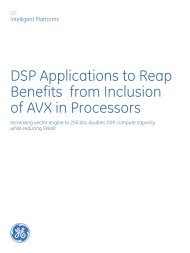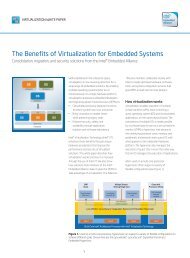Cloud Media Processing - Embedded Community - Intel
Cloud Media Processing - Embedded Community - Intel
Cloud Media Processing - Embedded Community - Intel
You also want an ePaper? Increase the reach of your titles
YUMPU automatically turns print PDFs into web optimized ePapers that Google loves.
Overcoming Challenges<br />
Around MPaaS<br />
The motivations for the industry to consider cloud<br />
computing, and more specifically media processing as<br />
a service, are usually grounded on the financial benefits.<br />
That is why cloud computing is also characterized as a<br />
financial model first, but then also needs to be balanced<br />
with technical realities in delivering a real-time<br />
telecommunications service.<br />
Leveraging cloud computing for IP media services<br />
requires changes to the underlying network architecture<br />
in order to adapt the new ways data and applications<br />
will move between customer machines and central<br />
offices/data centers. For example, public access<br />
networks need to be upgraded to deliver greater<br />
bandwidth, higher quality of service (QoS) and improved<br />
reliability, among other things. Moreover, MPaaS must<br />
run on shared computing platforms and meet stringent<br />
QoS requirements despite the reliance on public<br />
networks, which are far less predictable than private<br />
networks. The following sections describe many of<br />
the challenges facing networking and telecom solution<br />
providers in the delivery of MPaaS, and how Radisys<br />
solutions are helping to address them.<br />
Real-time Network Performance<br />
Traditional Internet applications do not have strict<br />
real-time performance constraints. Most users wouldn’t<br />
complain if a web page download took a half second or<br />
longer, whereas such a delay is unacceptable for audio<br />
and video communications. Based on user perception<br />
studies, most people consider the benchmark of 150<br />
milliseconds (ms) as the maximum tolerable delay for<br />
a satisfactory voice call. If the delay is greater, users<br />
will notice the delay, which will negatively impact the<br />
communications experience.<br />
Today, many telecom service providers choose to<br />
purchase their own IP media processing equipment<br />
and QoS-enabled IP network infrastructure in order<br />
to deliver the real-time network performance needed<br />
to ensure an acceptable quality of experience (QoE)<br />
for subscribers. Likewise, control over equipment is<br />
especially critical for service providers who implement<br />
<strong>Cloud</strong> <strong>Media</strong> <strong>Processing</strong> | Radisys White Paper<br />
virtual private networks (VPNs) designed to improve IP<br />
communications quality through better performance,<br />
lower delay and less jitter than the Internet. When<br />
quality of experience is a top priority, it’s imperative<br />
that service providers test the end-to-end network<br />
performance of IP media services at maximum load.<br />
The same is true for those deploying IP media services<br />
on cloud infrastructure; it is important to closely look<br />
at the network performance, along with the costs for<br />
delivering that performance, with your service provider.<br />
Radisys Solution: Real-time performance is<br />
designed into Radisys media servers, enabling both<br />
DSP hardware-based and software-based versions<br />
in virtualized environments running on <strong>Intel</strong> ® multicore<br />
processors to satisfy comparable latency<br />
specifications. Employing patented technology,<br />
all Radisys media servers (see sidebar: <strong>Media</strong><br />
Servers in the <strong>Cloud</strong>) implement a real-time control<br />
layer that sits on top of the operating system. This<br />
layer enhances DSP, multi-core and multi-processor<br />
architectures by providing real-time optimizations<br />
specifically tuned for the deterministic response<br />
times needed for IP media processing.<br />
The Radisys Software <strong>Media</strong> Server also utilizes<br />
<strong>Intel</strong> ® Integrated Performance Primitives (<strong>Intel</strong> ® IPP)—<br />
an extensive library of multi-core-ready, highly<br />
optimized software functions for multimedia and<br />
communications applications. <strong>Intel</strong> ® IPP functions<br />
deliver parallel performance beyond what optimized<br />
compilers alone can deliver, enabling Radisys to<br />
execute packet and jitter buffer processing within<br />
the strict 5-millisecond packet processing increments<br />
required by in high-performance telecommunication<br />
applications using Real-time Transport Protocol<br />
(RTP) media streams.<br />
In addition, the resource manager differentiates<br />
processing tasks (‘hard-real-time’ versus ‘nearreal-time’)<br />
and distributes them independently.<br />
Ensuring the hard-real-time processes have sufficient<br />
computing power, the resource manager reallocates<br />
CPU, DSP, memory and I/O resources as needed.<br />
This optimizes application performance based on<br />
the available computing resources, thus reducing<br />
cost for a given performance level.<br />
5













